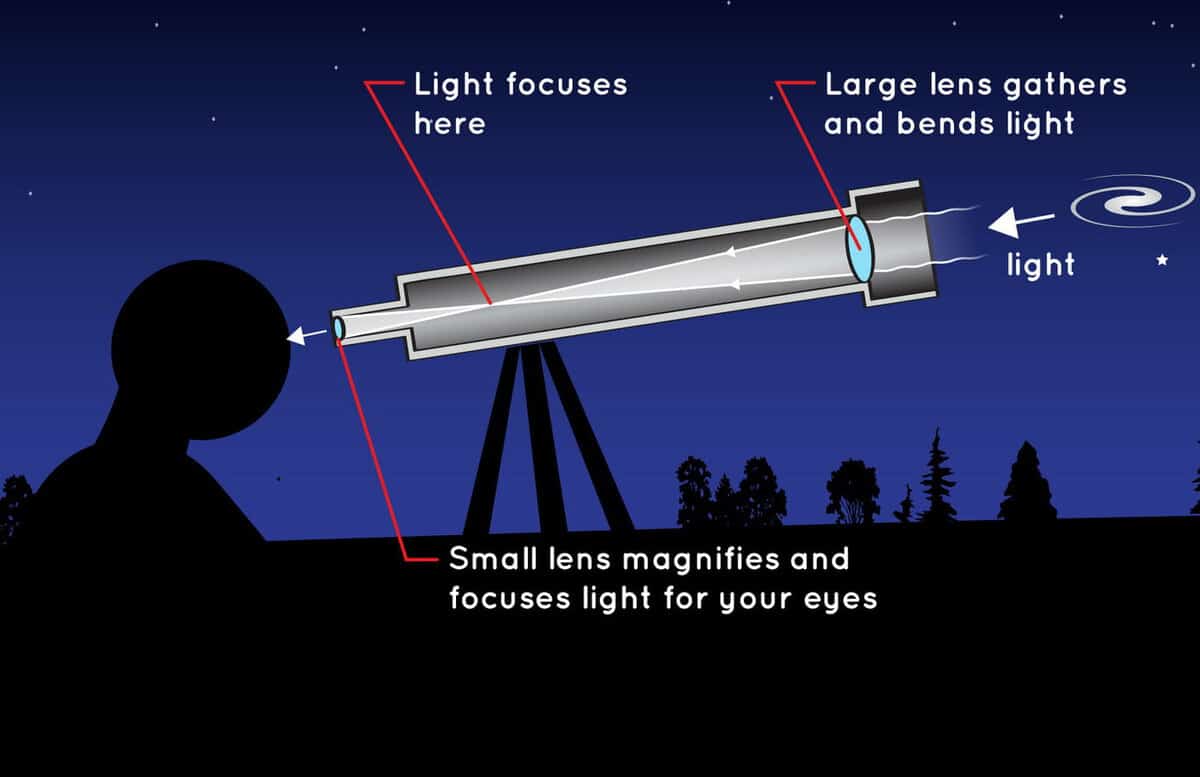Allow’s discuss the concept of telescopes. Most individuals are familiar with what a telescope is. However, not everyone realizes that each of us possesses a telescope, or rather, two telescopes – our eyes. Every living creature, likewise, has a set of telescopic eyes, with some even possessing four pairs. For instance, spiders.
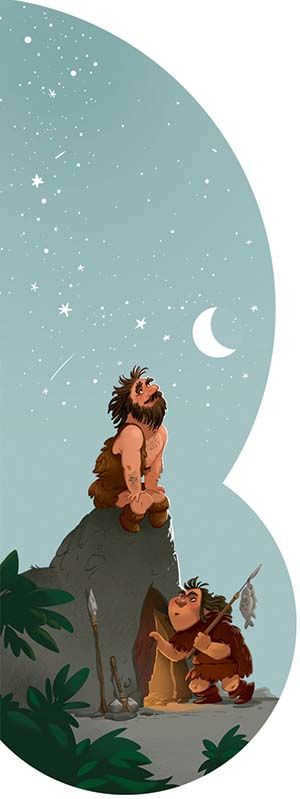
Essentially, our eyes can be compared to telescopes. However, the main difference lies in their size. The human eye has a pupil that is less than a centimeter in size, whereas a telescope’s pupil, also known as the lens, can be several meters in diameter. In fact, the pupil of a telescope can be larger than an entire room! This larger size allows the telescope to gather a significantly greater amount of light compared to our eyes. As a result, a telescope has the ability to observe extremely faint and distant celestial objects that would otherwise be invisible to the naked eye.
However, it is truly incredible that there are certain distant galaxies which can still be observed by the naked eye, even though it takes millions of years for light to reach them. Take, for instance, the Andromeda Nebula – a neighboring galaxy that has been transmitting light to us for a staggering 2.5 million years. Just imagine, the light we see today actually set off from the Andromeda Nebula when our ancestors were still living in the wild, clad in animal hides and wielding stone axes. They could have gazed upon the Andromeda Nebula 2.5 million years ago, despite lacking the technological advancements of computers that we now possess. In fact, they would have likely gazed at the night sky far more frequently than we do. Unfortunately, their vision was limited, and they would not have been able to perceive galaxies that were even more remote. The human eye simply lacks the necessary strength for such a feat.
Here’s a thought-provoking query: if humans were unaware of the existence of minuscule microorganisms and faraway celestial bodies that are not readily visible, what prompted them to develop microscopes and telescopes? After all, inventions are typically created out of necessity. No one would conceive of a square wheel – there would be no use for it. Hence, the question arises.
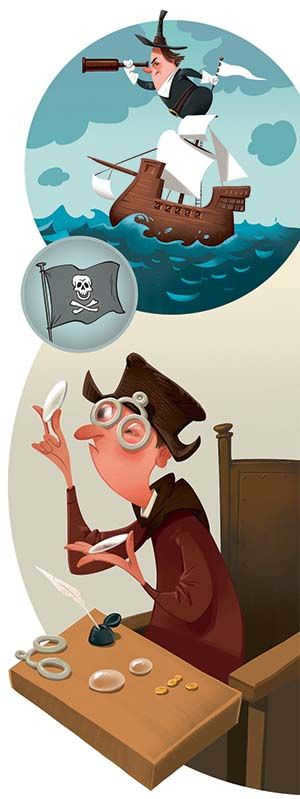
What is the story behind the invention of the telescope?
The invention of the telescope has a fascinating history.
In essence, the telescope is a simple device. It consists of a tube with magnifying lenses at both ends. That’s all – just a tube and two lenses! Magnifying lenses were actually invented many centuries before the telescope. They were originally used for eyeglasses, which proved to be a valuable invention for people with poor eyesight. However, the need for a telescope only arose much later. Who do you think needed it? Astronomers? No! It was sailors!
Ancient mariners typically refrained from venturing into the vast open sea, preferring to stick to the coastlines. This practice, known as coasting, allowed them to stay within familiar territory and navigate using visual cues. However, in the 15th century, advancements in ship technology made vessels larger and more reliable, enabling sailors to venture further into the ocean without fear. It was during this time that Christopher Columbus famously sailed across the Atlantic Ocean and discovered America. His fleet of three ships traversed the ocean alone, encountering no other vessels along the way. However, in the 16th century, there was a significant increase in maritime trade, with merchants sailing from America to Europe and from India to Europe. This increase in sea transportation also led to a rise in piracy, with pirates targeting these merchant vessels. This is where the need for telescopes arose. Imagine yourself sailing and spotting a ship in the distance, near the horizon. It becomes crucial to quickly determine the nature of the ship, its intentions, the number of cannons it carries, and the type of sails it possesses. If it turns out to be pirates, you would need to flee, but if it is a merchant ship, you could potentially rob it. In this era, being the first to spot a distant ship provided a significant advantage. It is worth noting that Dutch merchants had the largest fleet of merchant vessels during this time, and it was in Holland that the telescope was invented.

The ones responsible for this achievement were the eyeglass craftsmen. They initiated the production of miniature telescopes, capable of magnifying objects only 2 – 3 times, similar to the modern theater binoculars. Such a level of magnification proved to be sufficient for sailors: when standing on the deck of a ship that was constantly swaying due to the wind and waves in the vast ocean, it would have been challenging to observe through a telescope with a higher level of magnification.
The invention of the Dutch masters was soon discovered by Galileo Galilei, an Italian physicist and professor at the University of Padua. He was intrigued by the telescope and decided to build his own. However, the magnification of his first telescope was not strong enough, so he set out to create new ones with greater magnification. Eventually, he achieved magnifications of 15 and then 30 times. With his new telescopes, Galileo made groundbreaking discoveries. He observed mountains and meteorite craters on the Moon, satellites orbiting Jupiter, and clouds in Jupiter’s atmosphere. Additionally, he spotted numerous new stars in the sky. In essence, Galileo transformed a simple telescope into a powerful instrument that revealed previously unknown phenomena. This remarkable feat occurred in 1609, over 400 years ago.
DIY: Create Your Own Telescope!
Back in my school days, I came across the fascinating story of how Galileo Galilei invented the telescope. Inspired by his discovery, I too yearned to have my very own telescope to gaze at the moon and distant planets. In those days, computers and the internet were non-existent, making the prospect of viewing celestial bodies with your own eyes even more captivating than on a computer screen. However, affordable telescopes were scarce in stores, and my family’s financial circumstances made it impossible for me to even dream of purchasing one. That’s when I decided to embark on a mission to construct my own telescope.
As it turned out, the process was not as daunting as I had initially imagined. At its core, a telescope is simply a tube with magnifying glasses at both ends. Just a tube and two glasses! It did raise a question though – why two glasses instead of one? After all, we often use a single magnifying glass to enlarge images. This was the enigma of the telescope, and it was this very mystery that led to its invention!

Let’s ponder the reason why we are unable to perceive the intricate intricacies of an object without the aid of a magnifying glass. Allow me to propose an experiment: place a book at one end of a room, and position yourself at the opposite wall. The small inscriptions on the book’s cover remain imperceptible. Gradually approach the book – the letters start to become distinguishable, and eventually, the finer details become visible. However, if you were to position your eyes within the width of a palm from the book, you would be unable to discern anything – the image would appear blurry due to your eye’s inability to focus. This is precisely where a magnifying glass proves invaluable. By aiding the eye in focusing on nearby objects, a magnifying glass enables us to perceive their intricate details.
Is it possible to utilize a magnifying glass in order to observe intricate particulars on the surface of the Moon? Certainly not! It’s quite evident that regardless of whether we possess a magnifying glass, we would be unable to approach the celestial body. So how can we achieve this? That’s precisely where the concept of a telescope comes into play. We need to obtain an additional magnifying glass, one that will generate an image of a faraway entity in close proximity to us, allowing us to examine it more closely. Essentially, any magnifying glass will suffice for this purpose.
Experience it firsthand. Grab a magnifying glass and a plain sheet of paper, then head to a room with a source of brightness – like a light bulb or a sunlit window. Position the magnifying glass between the light source and the paper, and adjust it slightly until an image of the light source appears on the paper. Of course, achieving this requires some effort in finding the right distance between the magnifying glass and the paper. This process is known as “focusing the image”. The same principle applies to a telescope: one lens creates an image of the moon or a nearby planet, while another lens, known as the eyepiece, enables us to get a closer look and observe its intricate details. The first lens is referred to as the “objective lens” because it faces the object of our observation. Meanwhile, the second lens, the eyepiece, is called so because our eye is pressed against it for viewing.

Do you find paper too soft? Well, think again! All you need to do is take a long, cylindrical stick with a diameter slightly smaller than the objective lens, and wrap the paper around it. Make sure to apply glue to each layer as you go. Once the glue is dry, the paper tube will be as sturdy as wood while remaining lightweight. By creating a telescope similar to Galileo’s, I was able to replicate all of his groundbreaking discoveries. I observed mountains and craters on the Moon, stars in the Milky Way, and even the satellites of Jupiter. While I have since upgraded to better telescopes, I still cherish that first one I made.
Learning from nature
Since the time when Galileo crafted the initial telescopes, astronomers have been making advancements in their designs. Optical device creators are constantly seeking innovative solutions, inventing new observation tools that allow for long-distance vision, night vision, and even the ability to perceive transparent objects and see through opaque ones. However, nature has been solving these very same problems for millions of years, constantly improving the visual capabilities of animals. Humans have an incredible opportunity to gain knowledge and insights from the natural world.
Animal eyes exhibit a wide range of variations. They possess unique abilities to perceive and focus light, as well as adapt to different environments such as air and water. This becomes particularly crucial for amphibious creatures like frogs or newts, as they require effective vision both underwater and on land. While humans have made significant discoveries through the invention of telescopes and cameras, they have also sought inspiration from nature. One remarkable example is the engineering of a novel astronomical telescope, inspired by the intricate design of a cancer’s eye. Interestingly, this telescope has been aptly named the crayfish eye.
In order to obtain a vivid and distinct image of a radiant object, the process of focusing is required, where the light is gathered together. This task can be accomplished by either using a convex lens or a concave mirror. In the case of vertebrate animals (including humans), as well as spiders and cephalopods (such as the octopus), the eye possesses a lenticular lens, which is composed of a convex cornea and lens. Similarly, lenticular telescopes, like the one created by Galileo, operate in the same manner. These telescopes are commonly referred to as refractors.

However, a concave mirror has the capability to concentrate light as well. As a result, astronomers later began constructing mirror telescopes. In numerous aspects, these reflector telescopes surpass lenticular refractors. And do you believe that nature didn’t “conceive” such a solution? It certainly did: mirror eyes also exist. For instance, a scallop mollusk possesses a mirror in its eye where light is reflected and gathered on the retina’s surface. The astronomical reflecting telescope is similarly structured. Nevertheless, astronomers developed this design independently, without taking inspiration from the scallop.
Subsequently, astronomers took it a step further and created a groundbreaking device known as a telescope, which incorporates both a lens and a mirror. However, it has been discovered that certain animals possess a similar ocular structure, featuring both a lens-crystal and a reflective layer. This remarkable adaptation enhances their visual capabilities, particularly in low-light environments. Nocturnal and deep-sea creatures, for instance, rely on this unique arrangement. In their eyes, light initially passes through the lens, converging onto the surface of the retina. Any remaining light that is not absorbed by the retina is then redirected by the mirror back onto the retina. Nonetheless, a portion of the reflected light manages to escape the eye, resulting in the eerie glow observed in the eyes of animals like cats and sharks in darkness. It is important to note that these animals do not possess an inherent ability to emit light (there are no light bulbs in a cat’s eyes!). Rather, their eyes only emit a faint glow when subjected to external sources of light, such as moonlight.
Both animals and humans possess eyes that are just as intricate as the most advanced optical devices, allowing them to see just as well, and sometimes even better. While a telescope can only focus on a portion of the sky at a time, our eyes have the capability to take in the entire view. However, when it comes to seeing objects that are very far away, our eyes require assistance. Thankfully, this assistance is readily available in the form of binoculars and telescopes.
In the world of astronomy, the initial use of a newly constructed telescope to observe celestial objects is referred to as “first light.” This momentous occasion holds great significance in the lifespan of any instrument.
For complex projects that come with a hefty price tag of several million dollars, extravagant ceremonies are often organized. These events feature speeches from renowned figures in the global community.
However, in the summer of 2013, in the suburbs of Salt Lake City, there was no grand celebration with toasts and champagne glasses. The ceremony was a solitary affair, with only one person in attendance – Mike Clements, who was then 50 years old. Clad in a work shirt and blue jeans, he stood amidst an overgrown field, next to the telescope that he had dedicated two years of his life to constructing.
The finished product resembled more of an improvised drilling rig, standing at a towering height of almost 11 meters and weighing a hefty 1.8 tons. The folding steel frame had been expertly crafted by a local welder, while the 177-centimeter mirror weighed in at around 400 kilograms.
Mike, a truck driver by profession, possessed no formal training in physics or astronomy, nor did he have an engineering background. He hadn’t even bothered with sketches during the design process, instead relying on a model he had pieced together using wooden popsicle sticks.
It’s absolutely stunning
Mike’s telescope doesn’t have a complicated pointing system – it has a round metal disk at its base, similar to a large hand-turned table. Mike rotates it in the correct direction and uses a bicycle handlebar to direct it towards the Swan Nebula, which is known as the “star nursery” of the Milky Way.
“When I peered through my telescope, I was left speechless,” Mike reminisces. “The view was absolutely stunning. Countless tiny luminous stars were engulfed by the immense expanse of the nebula. In that moment, I truly understood that all the hard work put into building it was completely worth it.”
Mike’s interest started in the 1960s. During a visit to the Griffith Observatory in Los Angeles, his parents sparked his curiosity. Using his father’s glasses and a cardboard tube from a toilet paper roll, Mike constructed his first makeshift “telescope.” When he turned 22, he became a member of the Santa Monica Astronomy Club. Alongside fellow enthusiasts, he ventured out of the city lights and into the mountains to observe the stars. They would unpack their equipment and embark on a celestial “expedition” across the night sky.
“Joshua Roth, a former student at the California Institute of Technology, recalls that Mike stood out from the rest of the club members who were already quite unusual. Roth vividly remembers the moment when Mike showed up at a retreat for amateur astronomers and started unpacking a telescope with a 56 cm mirror from his trunk. Typically, amateur astronomers were restricted to using equipment with much smaller 25 cm optics.”
Large telescopes come at a high price. Mike decided to drop out of his PhD program at the University of California, Los Angeles, because, in his own words, “all he could think about were new telescope projects and nothing else” during his professors’ tedious lectures. He found himself unemployed for a period of time until his friends suggested that he become a truck driver. Surprisingly, this job turned out to be a perfect fit for Mike – it provided him with a decent income and ample time to ponder over the intricacies of his next invention while behind the wheel, envisioning a device that could transport him to the most distant corners of the solar system.
Mike surpassed his limits by constructing a telescope equipped with a one-meter mirror, which is an impressive feat. To put it into perspective, the “Hubble” telescope has a mirror diameter of 240 cm. Amateur astronomers typically don’t have access to optics of such large dimensions. However, luck was on Mike’s side when he received a call in 2004 from an acquaintance who somehow acquired a 177-centimeter mirror, slightly over 30 cm thick. This mirror had an interesting history, as it was originally intended to be mounted on a government spy satellite during the Cold War. Unfortunately, it sustained damage during production and was subsequently put into storage.
Mike doesn’t disclose the exact amount he spent on the purchase, but he mentions that it took him a span of two years to clear his debts. Acquiring the rest of the telescope’s components consumed another six years. Only in early 2012, Mike was able to commence the construction process. Residing in a modest apartment complex, he sought permission from a neighboring couple to convert their garage into a personalized workshop. Without fail, every Sunday, which was his sole day off, Mike dedicated 18 months of relentless work to the project, regardless of scorching heat, freezing cold, or torrential rain.
Mike faced numerous challenges in order to achieve his dream, with logistics being the most significant. “I didn’t just construct a telescope,” he clarifies. “I had to develop an entire system for assembling and disassembling it.” To manage the 450-kilogram frame, he constructed a small crane that connected to the towbar of his old pickup truck. In order to install the 2×2 meter mirror frame, weighing nearly 600 kg, Mike acquired welding skills. Additionally, to apply a reflective coating of silver nitrate to the mirror’s surface, a procedure that typically costs thousands of dollars for industrial telescopes, he employed a regular weed control sprayer.
To add an extra layer of security while attaching the mirror to the base, Mike built a wooden support frame that spanned three meters in length. It’s worth contemplating – a single misstep could have resulted in the complete destruction of Mike’s aspirations. “There were several instances during the installation process that caused my heart to skip a beat,” he reminisces.
His goal is to enhance the portability of his telescope, enabling him to transport it to various locations, allowing a larger number of individuals to witness the immense beauty of nebulae. Initially, he will require a customized trailer, which Mike has already begun constructing.
Guidance from an expert
John Weiss, a publicity specialist for a NASA hardware development project at the University of Texas, suggests:
Reflectors
Purchase a pair of mirrors – one mirror should be convex and have a focal length of 20 cm, while the other mirror should be concave and have a focal length of 5 cm. Make sure that the concave mirror has a smaller diameter.
Cylinder
Locate a telescopic cylinder for documents that has an adjustable inner section for modifying the length (these can be found at larger stores specializing in office supplies). Trim both the inner and outer cylinders to a length of 15.2 cm to ensure proper positioning of the mirrors for focusing * .
Installation of the mirrors
Create circular pieces of cardboard with a diameter that fits each tube. Make holes in the cardboard disks to attach the lenses. Use adhesive to secure them to the cardboard ring.
Eyepiece placement
Insert the small lens into the inner part of the tube, which will serve as the eyepiece. Glue the larger lens onto the end of the section with the larger diameter, ensuring that the convex side is facing outward. To achieve focus, observe through the eyepiece and adjust the position of the larger tube until the image is clear.
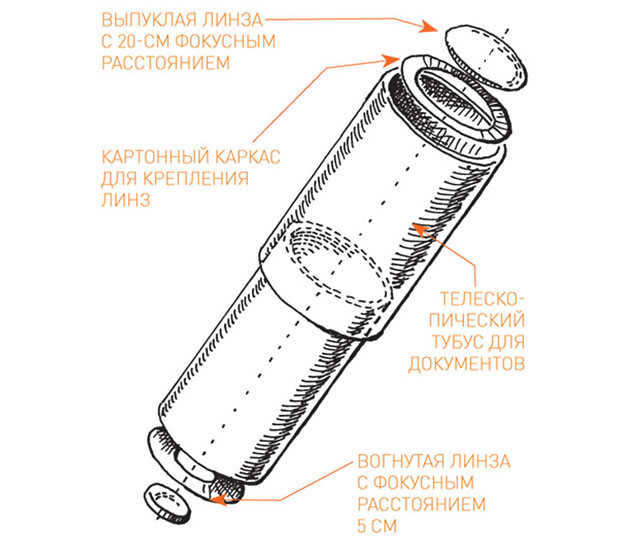
* To increase the power of your telescope, select a convex lens with a longer focal length. Increase this distance by 5 cm, divide it by 2, and then add 1. This will give you the distance at which the two lenses should be positioned apart – allowing you to adjust the length of the tube.
taras 25.10.2017 19:56 Reply
A telescope is a device that allows for the observation of faraway objects, commonly employed in the field of astronomy to examine the celestial sphere. Additionally, it has the capability to amplify and capture images of objects in outer space.
Origin and Evolution
Historical records indicate that the initial telescope was created by the renowned scientist Galileo Galilei in the year 1609. Galilei based his invention on the same principles utilized in the construction of maritime telescopes. However, he incorporated more potent lenses, carefully calculating their focusing in order to achieve a magnifying effect. As a result, the final iteration of his creation was capable of enlarging images up to twenty times. Galileo Galilei not only coined the modern name for his device, but was also the first to utilize optical equipment for the purpose of studying celestial bodies. Numerous groundbreaking discoveries in space were made possible thanks to this inaugural telescope. Presently, this remarkable instrument is preserved in a museum situated in Florence.
Arrangement of the telescope
The telescope is designed with a tube that is attached to a mount, known as the telescope mount, which allows for precise positioning of the device towards the desired object.
Within the tube, there are two main optical components – the eyepiece and objective lens – which work together to magnify distant objects. The level of magnification is determined by the focal length between these two components.
Additionally, the telescope has an adjustment mechanism that enables the user to change the focal length. This feature allows for different levels of magnification, allowing the user to zoom in on the object for greater detail. Initially, the telescope is set to its minimum settings, and then the image size is increased after the object has been targeted.
The level of magnification of a telescope is determined by the lenses that are used as the objective and eyepiece. The cost of the instrument increases as the magnification level increases. Classical telescopes with a more complex design include multiple lenses that are installed in the tube, with each lens increasing the magnification of the device.
Categories of telescopes based on the principle of operation and structure
The basic design of a telescope follows a classical scheme, which is similar to that of binoculars, telescopes, and microscopes. However, telescopes have larger lenses and a unique focusing mechanism. Furthermore, other designs have been developed and are currently in use.
- The Dioptric telescope.
- The Catoptric telescope.
- The Combined telescope.
- The Radio telescopes.
- The Infrared telescope.
All of these telescopes operate based on distinct principles, possess varying production costs, and exhibit differences in their magnification ratios. Infrared and radio telescopes are primarily utilized for professional research, while the remaining types can be compact and suitable for installation outside observatories or in private residences.
Dioptric
A dioptric telescope is a traditional optical device equipped with lenses. Its functionality is based on the fact that the lens of the objective gathers the light emitted by celestial objects. The lens, or a cluster of lenses, is always convex in shape, causing the light passing through it to converge at a focal point. To enable the human eye to observe the resulting image, it needs to be focused onto an eyepiece. The key requirement for the telescope to function properly is the alignment of the focal point of the objective lens with the eyepiece.
Catoptric
Mirror telescopes are also known as catoptric telescopes. These telescopes utilize a concave mirror as their primary component. The mirror collects and reflects the light from stars and other celestial objects to the eyepiece. One major advantage of this type of telescope is its ability to fully transmit the spectrum of light. In contrast, dioptric telescopes, which rely on lenses, tend to distort the light passing through them, resulting in an image that may not accurately represent reality. Mirror telescopes, on the other hand, provide a true representation of the magnified object, including its color, brightness, and depth of dark areas.
One drawback of mirror telescopes is their restricted field of view. They only capture a small portion of the image, preventing you from seeing the complete picture like optical devices do. However, mirror telescopes are more cost-effective to produce, leading to a higher production volume compared to other types of telescopes. As a result, these are the preferred choice for hobbyists.
This category of devices encompasses catadioptric telescopes. They utilize lenses and a concave mirror as their primary components. These devices offer a high-quality image and a wider field of view compared to traditional mirror telescopes.
These devices are further divided into two main subcategories:
Each of them is named after their respective inventors. The Schmidt-Cassegrain telescope features an aperture in the center of the mirror’s curvature, allowing for a larger field of view and eliminating spherical aberration and deviation.
Devices constructed based on the Maksutov-Kassegren principle include an optical lens located at the focal plane. This lens is convex on one side and flat on the other, compensating for field curvature and preventing spherical deviation.
Radio telescopes
Radio telescopes are significantly more expensive than previous instruments, costing many orders of magnitude higher. They are not suitable for amateur observation of space due to their size and cost. These devices are specifically designed for precise scientific research and do not include optical elements for capturing light from space objects. Instead, they use large antennas to detect space signals at a single frequency. These antennas can have a diameter of up to 25 meters. The data collected by radio telescopes is then transmitted to computer equipment, which converts the signals into visual images.
Typically, radio telescope antennas are interconnected, and they can be situated in various locations around the globe. The VBA network is a prime example of these types of projects, as it has been in operation since 1993. This particular system is capable of generating visual representations of objects that have a brightness temperature exceeding one million degrees Kelvin. The antennas within this network are widely spread, with the furthest one being situated 8600 km away from the central base.
Infrared
These devices are capable of detecting infrared radiation emitted by objects. Essentially, they respond to heat. With their exceptional sensitivity, these devices can detect infrared radiation that is imperceptible to the human skin.
The telescope lens reflects the infrared radiation and focuses it onto a single point. The device’s sensitive component then measures the heat, converts it into visual data, and captures the result for further analysis.
Within the Earth’s atmosphere, it is not possible to utilize infrared telescopes due to the hindrance caused by the radiation emitted by the planet. This interference greatly impacts the sensitivity of the telescopes. As a result, the utilization of infrared telescopes is limited to outer space. The Hubble spacecraft is the most renowned example of such instruments, which was launched in 1990 through a collaborative effort between the American NASA and the European Space Agency. Apart from infrared cameras, this device is also equipped with reflectors that enable image capture using the Ritchie-Cretien system.
How to Choose a Telescope for Amateur Sky Observation
When it comes to selecting a telescope for amateur sky observation, there are a few options to consider: lenticular, mirror, or combined instruments. However, if you also plan on observing terrestrial objects, you’ll need to purchase additional accessories.
For example, mirror and combined telescopes typically produce a mirrored image from left to right. This can be corrected by using a diagonal prism instead of a standard diagonal mirror. Many telescope sets already include these additional parts to compensate for distortions. It’s important to pay attention to this when buying a telescope, especially if you’re interested in observing terrestrial objects. For studying celestial bodies, the inverted or reflected image is not as critical.
The three primary factors to consider when selecting a telescope are:
The brightness of the telescope is determined by the ratio between the focal length and the diameter of the objective lens. A high level of brightness enables the capturing of clear images through the eyepiece. If the brightness ratio is 1:10, even relatively bright areas on celestial bodies may appear as dark spots. For amateur astronomers, telescopes with aperture ratios of 1:5 and 1:7 are considered ideal. When purchasing a telescope, it is always preferable to choose one with a larger objective lens rather than a smaller one.
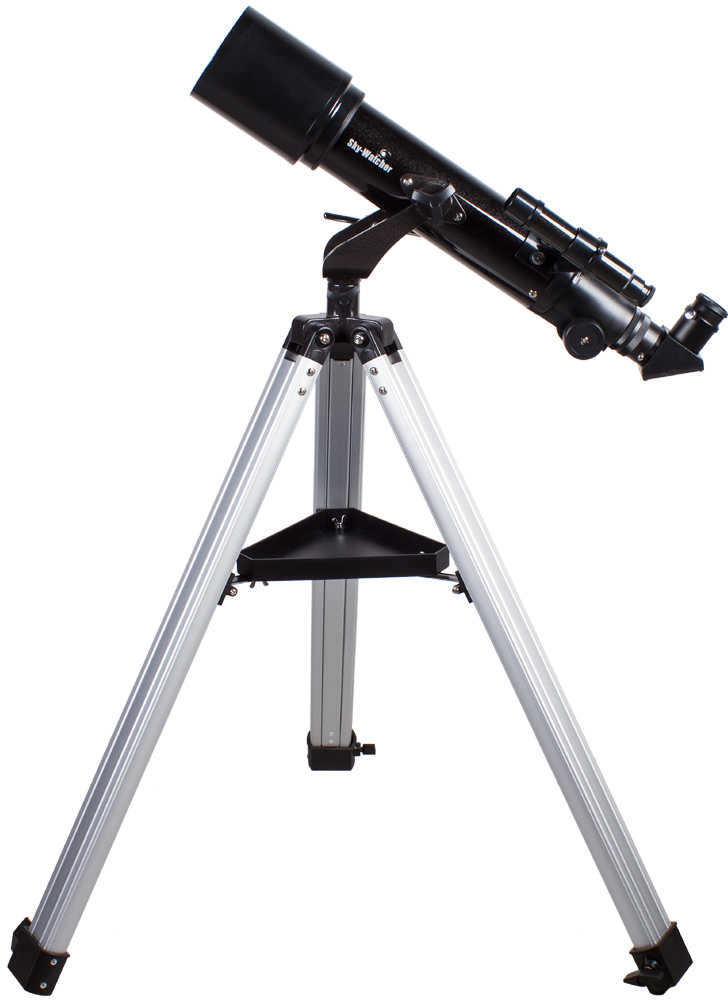
A telescope is an instrument that enables us to explore the universe. It is comprised of optical and mechanical components. The optical tube and its attachments, which work together to create the image, make up the first part. The mount and tripod form the second part. These components are essential for positioning the telescope towards celestial objects. A diagram of the telescope in its overall form can be found in various books, both in print and online.
Designs of Optical Tubes: A Visual Guide to Different Types of Telescopes
The optical tubes of telescopes come in various designs, each offering unique features and capabilities. One popular type is the refractor, which was first invented in 1609 by Galileo Galilei. Refractors use a lenticular lens and eyepiece to create images. Although the optical design has evolved over the years, the basic concept remains the same.
Refractors are particularly well-suited for observing planets and the Moon. However, they are prone to chromatic aberrations, which manifest as colored halos around bright objects. To address this issue, high-quality refractors are equipped with additional achromatic or apochromatic lenses. Unfortunately, this also increases the cost of the telescope. It is worth noting that a premium refractor is always a costly investment.
Reflectors are a type of telescope that use a mirror, either spherical or parabolic, to gather light. The light is then reflected off the mirror and onto a smaller mirror, redirecting it outside the optical tube to the eyepiece assembly. This design allows for a magnified view of the night sky, with minimized chromatic aberration and a bright, clear image of even the most distant and dim astronomical objects. The Newton reflector is one of the most commonly used types of reflecting telescopes.
However, catadioptrics already come equipped with both mirrors and lenses. These telescopes rely on a main spherical mirror to form the image, along with a special corrective lens called a menisk to enhance the picture quality. Catadioptrics offer several key advantages, such as their affordable price, compact size, and lightweight design. On the downside, they do tend to require a longer time for thermal stabilization and may not offer the highest level of brightness (especially when compared to reflectors, for instance).
Every optical configuration is divided into different subtypes. The fundamental concept of the design remains unchanged, but the components of the optics are arranged in different ways. Each structure of the optical telescope has its own advantages and disadvantages, so when selecting a model, it should be based on the observations that you intend to carry out. For observing terrestrial and planetary objects, the refractor will provide the best image, while objects in deep space are typically observed with reflectors. For observing the countryside, a mirror-lens telescope would be a good choice. There are no telescopes that are inherently good or bad; rather, they are either suitable or unsuitable for your specific tasks.
The manufacturer reserves the right to change the price, product lineup, and specifications or discontinue the product without prior notice.

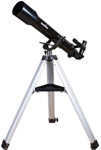
Additional reviews and articles on telescopes and astronomy:
Evaluations of optical gear and accompanying products:
Guides on telescopes. Selecting, configuring, and conducting initial observations:
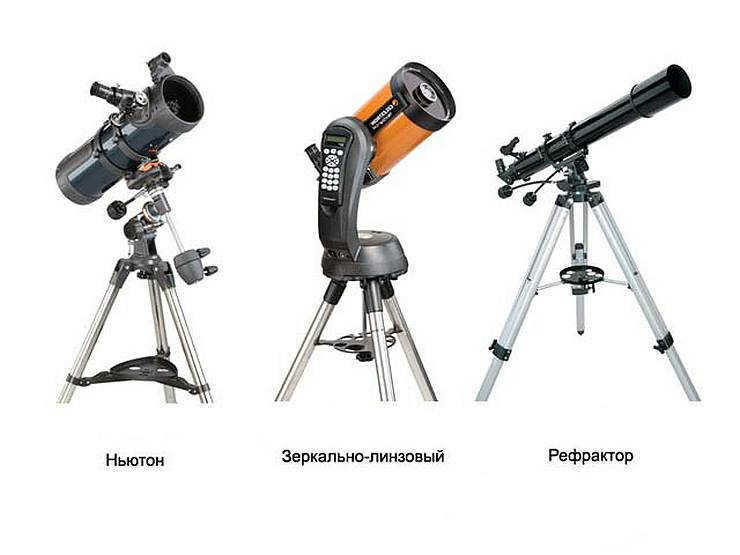

Currently, there is a wide range of telescopes available for purchase. Manufacturers in the modern era prioritize customer satisfaction and continuously strive to enhance each model, gradually addressing any existing limitations.
On the whole, these devices are constructed based on a shared blueprint. What does the typical structure of a telescope entail? This will be explored in the following sections.
Telescope Tube
The primary component of the telescope is the tube. The lens is housed inside the tube, where it receives incoming rays of light. There are various types of lenses used in telescopes, including reflectors, catadioptric lenses, and refractors. Each type has its own advantages and disadvantages, which users consider before making a purchase.
Essential components of a telescope include the tube and the eyepiece.
In addition to the tube, the telescope also features a finder. This can be described as a miniature tube connected to the main tube, providing a magnification of 6-10 times. The finder is used for initial aiming at the object being observed.
Eyepiece
The eyepiece is a crucial component of every telescope. It is responsible for providing the user with the ability to observe objects. The length of this interchangeable part determines the level of magnification, with shorter eyepieces offering greater magnification but a smaller field of view. To optimize the viewing experience, it is recommended to acquire multiple eyepieces to accompany the device, including both constant and variable focus options.
Indeed, if one intends to marvel at the moon, it is essential to acquire a dedicated moon filter to safeguard the eyes from excessive brightness. Additionally, there are filters available that can effectively diminish the interference caused by urban lights, although they tend to be rather pricey. Moreover, in order to observe objects in their proper orientation, diagonal mirrors are necessary, which can redirect the rays either by 45 or 90 degrees, depending on the type.
These various components can be found in nearly all telescopes, regardless of their type or ultimate price.
The telescope tube is an essential component of optical telescopes. Refractors, for instance, are equipped with a hermetically sealed tube that effectively shields the lenses from dust and moisture. On the other hand, when using a reflector, it is crucial to keep the tube open during observation to prevent the accumulation of dust within the system and to avoid image degradation caused by air currents. In addition to their sealing properties, telescope tubes also differ in terms of their length. Refractors, with their imposing size, can appear quite intimidating, whereas reflectors are relatively compact and more easily portable. Mirror-lens telescopes, although they have a shorter tube, tend to be significantly heavier compared to reflectors.
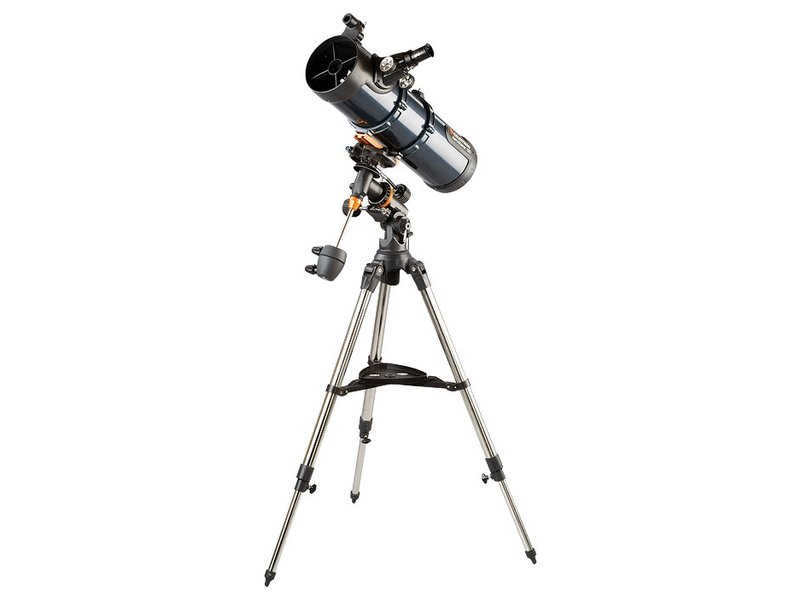
The arrangement of a telescope. A telescope is typically mounted on a tripod using a mounting system. The mounting system is composed of two axes for pointing that are positioned at right angles to each other, as well as drives and a system for referencing rotation angles.
There are two categories of mounts available for telescopes: equatorial mounts and alt-azimuthal mounts. An equatorial mount is designed to align one of the telescope’s planes perpendicular to the Earth’s axis, which allows for easy compensation for the daily rotation of the Earth. In comparison, an alt-azimuthal mount has both vertical and horizontal axes of rotation, enabling the telescope to be rotated in both elevation and azimuth. While it is more challenging to compensate for the Earth’s rotation with this type of mount, it is simpler, more compact, and less expensive than an equatorial mount.
The primary characteristics of optical telescopes consist of the diameter of the objective lens (also known as the aperture) and the focal length of said objective lens.
The aperture is determined by the diameter of the lens in a refractor or the main mirror in a reflector and is typically measured in inches or millimeters. In essence, the aperture represents the diameter of the light beam that the telescope can effectively gather. The diameter of the objective lens determines the resolving power of the telescope, which refers to the smallest angular distance between distinguishable objects observable through the telescope.
The distance at which a mirror or objective lens creates an image of an infinitely distant object is known as the focal length of a telescope lens. The focal length is responsible for the luminosity of the telescope, which is determined by the ratio of the focal length to the diameter of the objective lens. Additionally, the focal length of the objective lens in relation to the eyepiece determines the optical magnification of the telescope.
How is a telescope constructed? Building a telescope involves two crucial tasks: magnifying objects located at a significant distance and gathering the sun’s rays. Surprisingly, the latter task is more important than the former. Even a toy telescope with the correct equipment can yield satisfactory results, but discerning the resulting image can be quite challenging. So, what is the primary difficulty in this process?
There are two primary types of telescopes: refractors (lenticular) and reflectors.
How a refractor telescope functions
A refractor telescope is composed of a double-convex objective lens and a double-convex eyepiece. The objective lens gathers the light rays from the source and brings them to a focal point. At the focal point, an actual image of the observed object is formed. This image is then magnified using the eyepiece.

A telescope has two main functions. The first function is to gather light from distant celestial bodies using a lens. The larger the lens, the more light it can gather.
The second function is to produce a magnified image of the object being studied. What does this mean? The telescope’s focus creates an image of the celestial body, which is much smaller than the actual body itself. However, this image is closer to the observer and can be viewed through the eyepiece at a much larger angle than the naked eye can see the celestial body itself.
Various eyepieces can be utilized to achieve varying levels of magnification. As the magnification increases, the field of view of the telescope will decrease. When observing the Moon, for example, using a 300x magnification will reveal more intricate details compared to using a 30x magnification. However, the trade-off is that the field of view will encompass a much smaller portion of the lunar surface.
If the object being observed has a significant angular size, such as the Sun, Moon, planets, comets, nebulae, or galaxies, the telescope will create an enlarged image, enabling the detection of details that are not visible to the naked eye.
When it comes to observing stars, the situation is quite different. Even the closest stars are positioned so far away from us that, even when viewed through the most powerful telescopes previously mentioned, they still appear as mere specks. Therefore, telescopes do not magnify the size of stars, but rather amplify their brightness significantly.
Simultaneously, due to the fact that stars are incredibly small in comparison to the vast distances between them, telescopes actually make the apparent gaps between stars appear larger, as though they are moving further apart. This allows us, in certain cases, to observe individual stars that would otherwise appear as one to the naked eye.
The use of lens systems in modern refractor telescopes is a highly intricate process. It should be noted that a basic biconvex lens is not without its flaws. Specifically, when light rays from celestial bodies pass through such a lens, they do not converge to a single point. This phenomenon is known as spherical aberration. The presence of spherical aberration prevents the formation of a clear and detailed image of the observed object, both in the center and at the periphery of the field of view. If one were to focus on the center, the edges would appear blurry, and vice versa, if the edges were to be focused, the center would become blurred.
One disadvantage that can arise in telescopes is known as chromatic aberration. This occurs when light emitted from celestial sources contains rays of different colors. As these rays pass through the lens, they are refracted and focused at different points along the optical axis of the telescope. Essentially, each color forms its own focus, resulting in a distorted image of objects such as stars. To address this issue, composite lenses must be used, requiring precise manufacturing and presenting significant challenges.
Due to these challenges, it is not surprising that modern astronomy has favored telescopes that utilize concave mirrors instead of lenses. The first telescope of this kind was designed and constructed by Isaac Newton in 1668.
In a reflector telescope, the focal point is located between the lens and the object being observed, allowing for the incident rays to be directed towards it. To view the image produced by the lens, an extra mirror is positioned between the main mirror and its focal point. This mirror redirects the reflected rays from the lens, allowing the resulting image to be seen either from the side or through a central hole in the main mirror. In certain large telescopes, such as the six-meter telescope, the observer’s cabin is situated directly within the tube.

Reflecting telescopes do not suffer from chromatic aberration since the light is not separated as it bounces off the mirror’s surface. To eliminate spherical aberration, the mirror is shaped into a parabolic curve. A parabolic surface has the unique ability to focus all parallel rays onto a single point along the optical axis.
The distance from the center of the lens to the primary focal point. the intersection point of the parallel beam of rays that have passed through the lens objective or reflected by the mirror is known as the main focal length of the telescope. And the ratio of the lens diameter to its primary focal length – the relative aperture of the lens. In photography cameras, the relative aperture is commonly referred to as the aperture. Lenses with an aperture of 1:2 to 1:6 are considered fast lenses, allowing for the capture of dimly lit celestial objects such as comets, nebulae, and star fields. The relative aperture of a typical medium refractor telescope is around 1:15.
The capabilities of a telescope depend on the size of its objective lens. A larger lens area enables the observation of fainter stars using the same telescope. For example, a telescope with an 80 mm lens diameter can detect stars up to the 11th magnitude, while a telescope with a lens diameter of 760 mm can detect stars up to the 16.2 magnitude.
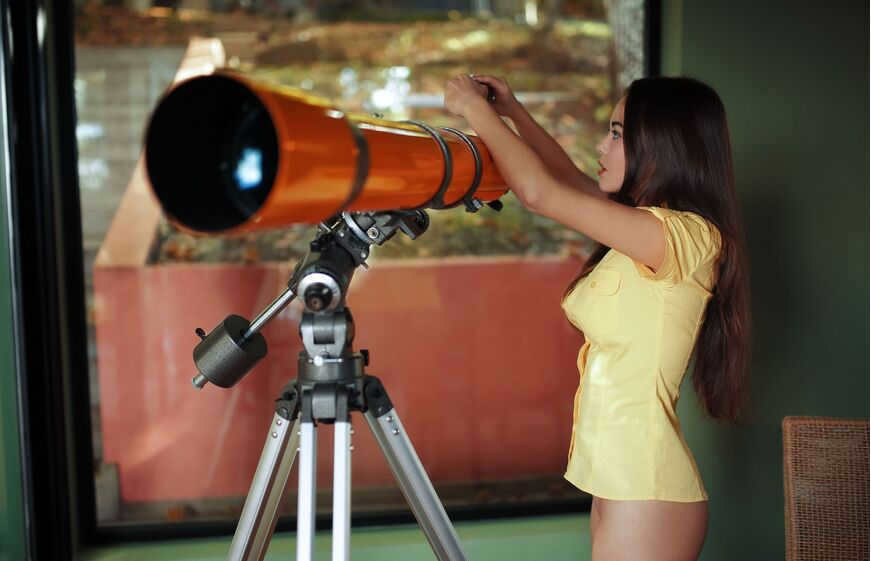
A telescope is a tool that is utilized to observe celestial bodies and other objects that are located far away. It is made up of a few fundamental parts: an objective lens, a mirror or lens, a mechanism for focusing, and a system for mounting.
The lens or mirror collects light from the object that is being observed and directs it onto the image plane. The focusing mechanism enables you to adjust the focal length of the lens or mirror in order to achieve a clear and sharp image.
Contemporary telescopes can possess a variety of characteristics such as magnification, luminosity, field of view, resolution, and other parameters that determine their capabilities and effectiveness in observing objects.
There are also telescopes called reflector telescopes, which utilize a system of mirrors to concentrate light onto the object being observed, as well as telescopes that employ digital cameras to capture high-quality images.
Telescopes can come in various types, depending on their design and intended purpose. For instance, there are refractor telescopes that utilize lens optics to produce an image, reflector telescopes that reflect light off a mirror, and mirror-lens telescopes that combine both types of optics.
All in all, a telescope serves as a crucial tool for exploring space and acquiring fresh insights into our universe.
The history of telescope creation dates back to ancient times. In antiquity, people utilized magnifying glasses to observe distant objects. However, the true telescope was only developed in the late 16th century by Galileo Galilei.
In 1608, Galileo constructed the initial telescope that enabled him to study celestial objects. He utilized a mirror composed of polished copper. This telescope had a diameter of 37.5 cm and could magnify objects 25 times.
Subsequently, in the 17th century, other telescopes emerged that utilized various optical components such as lenses and prisms. In the 18th century, telescopes utilizing concave mirrors were created, which expanded the capabilities of observing celestial objects.
In the 19th century, advancements in science and technology led to the emergence of novel telescope designs, including mirror telescopes and radio telescopes. As the 20th century progressed, telescopes were developed with improved resolution, enabling the observation of microscopic objects on Earth.
Presently, these instruments find applications in a wide range of scientific disciplines, including astronomy, physics, geology, and medicine. They facilitate the study of remote galaxies, stars, planets, and other celestial bodies, as well as the exploration of the microcosm within our own planet.
How does a telescope function?
A telescope operates by directing the light emitted by a distant object onto a sensitive surface, such as a photographic plate or camera sensor. This process is known as the optical system of the telescope.
There are three key components to a telescope: the mirror, the eyepiece, and the optical system. The mirror is the central component of the telescope and is responsible for reflecting the light from the distant object onto a sensitive surface. The eyepiece is employed to focus the image onto the observer’s eye. The optical system is comprised of various lenses, mirrors, and other optical elements that collaborate to produce an image of the distant object.
When the mirror of the telescope reflects the light from the distant object, it is directed onto the optical system. This system consists of lenses, prisms, and other optical elements that alter the path and form of the light in order to concentrate it onto a sensitive surface. The image of the distant object then becomes visible on the sensitive surface of the telescope.
- The objective lens (either a lens or mirror) gathers light from the object at the focus point.
- The focus point is situated at the center of the lens and is positioned at an angle to the optical axis of the telescope.
- The optical axis is a line that passes through the center of the lens and the center of the observation chamber.
- The observation chamber is located along the telescope’s axis and is utilized for observing an object.
- The observer can view the image of the object through the eyepiece, which provides a magnification that varies based on the design and focal length of the lens.
- By using a telescope, you can enlarge the image of an object and obtain a more comprehensive understanding of its composition and characteristics.
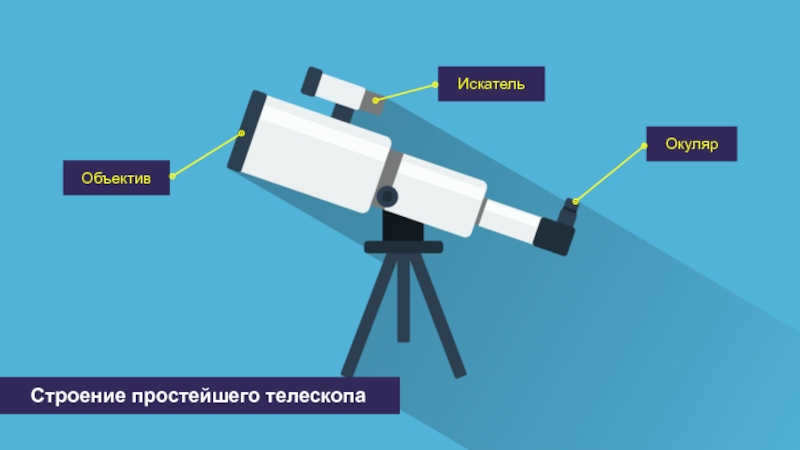
Telescope Construction and Functionality
A telescope is comprised of three primary components: the pointing system, the focusing system, and the optical system. The pointing system is responsible for maneuvering the telescope in space in order to align it with a specific target. This can be achieved manually or through the use of computerized or other automated mechanisms.
Optical system
The optical system of a telescope consists of various optical elements that are employed to create an image of the observed object on the eyepiece or camera. It comprises:
- The lens, which gathers light from an object and directs it onto the next element.
- The eyepiece, which magnifies and enhances the image produced by the lens.
- A viewfinder, a device that enables the observer to view an object’s image without directly looking through the eyepiece.
- A mirror, used to reflect light from the lens onto the eyepiece or viewfinder.
- The aperture, the diameter of the opening through which light passes in the telescope’s optical system. A larger aperture allows more light to be collected, resulting in higher image quality.
- The distance between the lens and the eyepiece is known as the focal length. It plays a crucial role in determining the distance at which an object will appear when observed through the telescope.
- Resolution refers to the telescope’s capability to differentiate between two objects that are closely positioned. The greater the resolving power, the more intricate details can be observed in the resulting image.
This is the device that enables you to adjust the telescope’s position and focus the image on the object under observation. It typically comprises a rotating mechanism that facilitates movement of the telescope in any direction, as well as a focusing ring that controls the focal length.
The gyroscope pointing mechanism utilizes the Coriolis effect to maintain the telescope in a specific position in the sky. It can be employed to direct towards a specific star or constellation. It usually consists of two components: a pointing mechanism (such as a gyroscope) and a focusing mechanism (such as a lens system).
The focusing mechanism is used to alter the focal length of the telescope, enabling adjustments to the depth of field and the level of detail in the image. It may incorporate a system of lenses or mirrors that modify the angle of incidence of light on the camera sensor.
Tripod
The tripod serves as the foundation for securing the telescope, ensuring its stability during observations. Tripods can vary in their construction and the materials used.
A telescope tripod is a specialized mechanism designed to securely position and stabilize the telescope at a specific height. It plays a crucial role in maintaining the stability necessary for obtaining clear images and precise observations.
Telescope tripods are available in various types and sizes, depending on the specific telescope being used. Some models feature adjustable legs, allowing users to customize the height of their telescope based on the observing conditions.
Other tripods may include additional mounts for attaching accessories such as filters or eyepieces.
When selecting a mechanism, it is important to take into account its weight, stability, and ease of operation. It is also recommended to choose a tripod that is suitable for your specific telescope and observing conditions.
Additional Components
There are various accessories that can be added to the telescope to enhance its functionality and usability. For instance, these might include filters for altering the image’s color or a lunar filter for clearer Moon observation.
In general, the telescope’s design is dependent on its type and purpose. Nevertheless, fundamental elements like the optical system and pointing mechanism are shared by all telescopes.
Categories of telescopes
Refractive telescopes
Refractive telescopes utilize two focusing lenses positioned at a distance equal to the sum of their positive focal lengths. This configuration results in inverted images. The actual image plane is located between the lenses. The larger lens is known as the objective lens, while the lens facing the observer is referred to as the ocular lens (eyepiece).
One drawback of the Keplerian telescope is its limited field of view, which is determined by the size of the ocular lens. To expand the field of view, an additional field lens can be added.
Galileo’s telescope, on the other hand, produces non-inverted images and includes both focusing and defocusing lenses. It does not have a physical image plane.

When it comes to telescopes, the design of lenses is often quite straightforward, especially compared to cameras. This is particularly true if the application only requires a relatively small field of view. However, if a wider field of view is needed, more complex lens designs, such as those used in astrocameras, are necessary. More information on optical aberrations can be found below.
For telescopes that invert the image, there are two options: either accept the inversion or use additional optics to correct it. However, if the telescope is used for capturing images on photographic films or image sensors, the inversion is not a concern. Refractive telescopes are commonly used in the form of binoculars.
It’s worth noting that refractive telescopes can be made without lenses as well. Instead, they can be created using prisms, typically in the form of pairs of amorphous prisms.
Refractive Telescopes
Telescopes can also be created using solely reflective optics, meaning they use mirrors. While curved mirror surfaces make it easy to achieve focusing and magnification, design adaptations are necessary to deal with the change in the direction of the beam during reflection. There are two common solutions: the Cassegrain telescope and the Newton telescope.
Both of these telescopes have a secondary mirror that is suspended by a spider, which causes a circular central dimming of the primary mirror. This leads to some loss of resolution, which is avoided in other telescope designs. However, these alternative designs have their own issues due to inherent asymmetry.
As mentioned earlier, neither of these systems are afocal. Instead, they produce a focal point in a convenient location where an image sensor, such as for a camera, can be positioned. However, it is definitely possible to modify these telescopes into an afocal system for direct visual observation by a person.
Reflecting telescopes typically utilize an aspherical mirror. For instance, Cassegrain reflectors utilize a parabolic primary mirror and a hyperbolic secondary mirror that redirects light through an opening in the primary mirror.
The primary benefits are
Avoiding any dispersion of color is a significant advantage. This advantage was already recognized by Isaac Newton, who therefore devised the inaugural reflector telescope, known as the Newtonian telescope, in 1668.
It is possible to construct relatively large telescope mirrors that still possess a reasonable weight, whereas large lenses would become excessively heavy and costly. Consequently, reflecting telescopes have become a prevalent solution for astronomy.
Early reflecting telescopes encountered the issue of rapid degradation of reflecting surfaces when utilizing specular metal mirrors. However, this problem was largely resolved through the use of metal-coated first surface mirrors, which are based on glass or ceramic mirror substrates. These mirrors are also more durable and retain their shape more accurately, with some of them having minimal coefficients of thermal expansion.
Nowadays, glass-ceramic substrate materials with a significantly low coefficient of thermal expansion are commonly used for crafting highly accurate large telescope mirrors.
It is important to keep in mind that any deviations from the desired shape should ideally be minimized to a level that is much smaller than the length of one optical wavelength. To further enhance the precision of the wavefront, adaptive optics can be employed. This technology corrects distortions caused by the primary mirror not at their origin, but at a more convenient location where the beam path is more condensed.
Significant advancements have been made in the development of astronomical observation telescopes, particularly those with Cassegrain architecture. The largest of these telescopes boast impressive open apertures measuring approximately 10 meters in diameter.
However, one major challenge faced by astronomers is the diffraction limit for angular resolution, which often becomes unattainable due to atmospheric image distortion. Even when these telescopes are situated on elevated mountains, the atmospheric conditions can still hinder their performance. To address this issue, adaptive optics technology is increasingly employed to correct for these distortions.
To accurately measure the distortions and effectively apply corrections, astronomers can utilize either starlight or artificial laser guiding stars within the same telescope.
Furthermore, the field of telescope development is constantly evolving, with plans underway for the construction of even larger telescopes. These future telescopes are projected to have apertures exceeding 20 meters, and some may even surpass 30 meters in height.
There is also a need for high performance from the sensors utilized, which are primarily CCD in nature. Numerous telescopes employ larger sensor designs, which may include multiple CCD chips. These instruments often function at low temperatures in order to optimize sensitivity. Additionally, supplementary measurements can be obtained in low-light conditions, and noise subtraction algorithms can be implemented.
Certain prominent observatories, such as the European Southern Observatory in Chile with its Very Large Telescope, utilize a combination of multiple telescopes. By employing interferometry to merge the signals from these instruments, they are able to greatly enhance angular resolution.
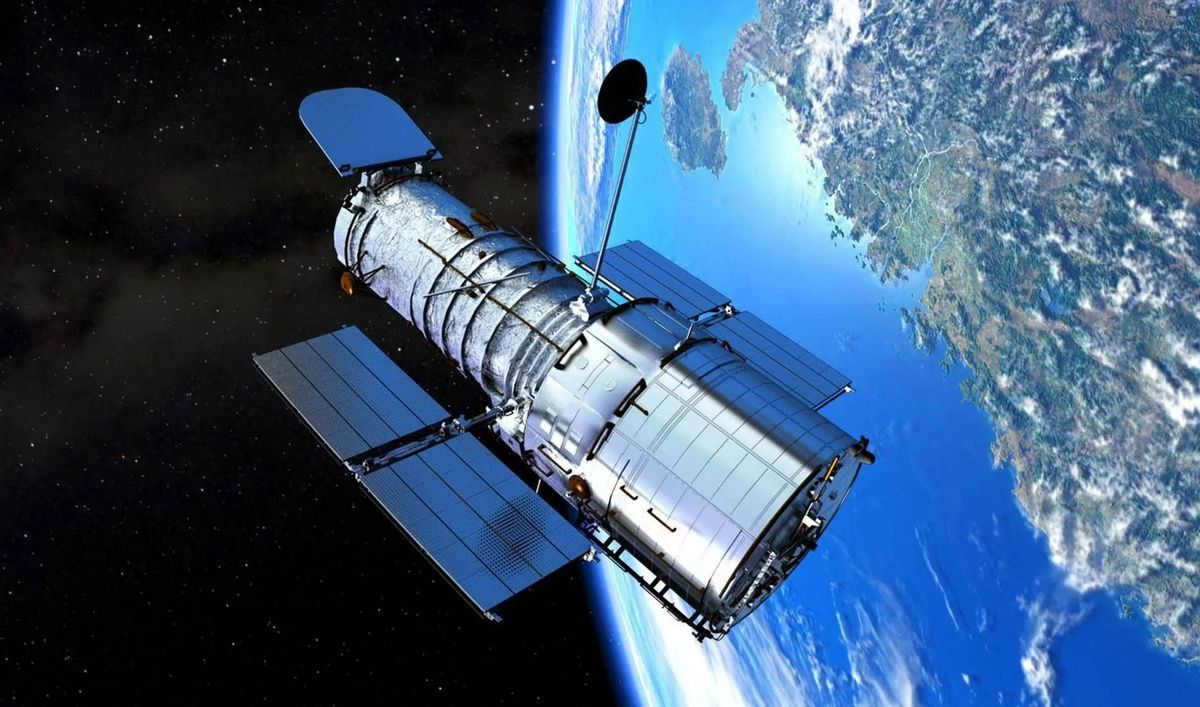
One way to overcome the issue of atmospheric distortion is to position the telescope beyond Earth’s atmosphere, typically in orbit around the planet. The most well-known example of this is the Hubble Space Telescope (HST), which was launched in 1990 and has been providing valuable astronomical images for many years.
Although its aperture size of 2.4 meters is relatively small compared to ground-based telescopes, the lack of atmospheric distortion ensures exceptional image quality. It can capture light in the visible, ultraviolet, and near-infrared ranges.
Other space telescopes have been launched at a later time, including the Herschel Telescope in 2009, which, however, functions in the far infrared spectrum. The upcoming James Webb Space Telescope is anticipated to encompass wavelengths ranging from 0.6 microns to 28.5 microns, featuring a primary mirror with a diameter of 6.5 meters.
Alternatively, rather than capturing images, light emitted by a star or galaxy can be examined, for instance, through the utilization of a highly sensitive spectrometer. In different scenarios, the polarization characteristics of light are meticulously investigated using polarimeters.
Furthermore, there are dedicated solar telescopes designed specifically for capturing intricate details of the Sun. In this case, brightness is certainly abundant; on the contrary, the system must be able to endure substantial optical powers.
Due to the relatively short distance of observation, the angular resolution needed is not as high as when observing distant stars. As a result, telescope designs for ground-based observations differ significantly from those used in other astronomical telescopes.
Ground-Based Telescopes
Small ground-based telescopes are often designed as handheld binoculars, consisting of two separate telescopes, one for each eye. The spatial separation between the two lenses can be increased beyond the distance between human eyes to enhance 3D vision.
In order to modify the beam paths, prisms can be used, which also correct for image inversion caused by other optical elements. Binoculars are commonly utilized for activities such as bird-watching, hunting, sports observation, and military reconnaissance.
Additionally, there are more affordable and lightweight options available in the form of compact monoculars designed for single-eye viewing.
Monoculars are often utilized in the construction of large telescopes used in geodesy applications. These telescopes are typically mounted on a flexible system that allows for precise observation in specific directions.
Another application of telescopes is found in the use of telescopic sights, which are small telescopes mounted on rifles to facilitate precise aiming. Similar telescopes are also employed in other types of weapons.
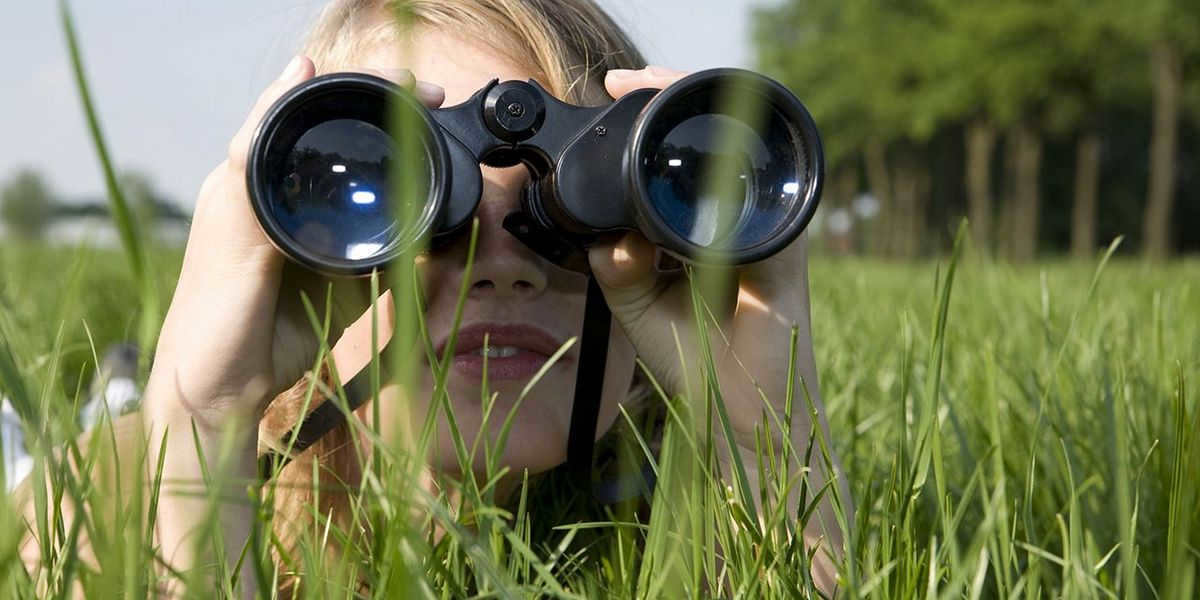
Optical Lens Telescopes
Catadioptric telescopes are the ones that utilize a combination of refractive and reflective optics.
By blending these two types of optics, catadioptric telescopes offer more options for correcting image aberrations, even when dealing with a wide field of view. Additionally, this combination allows for the development of compact and lightweight designs. One of the simplest types of catadioptric telescopes is the catadioptric dialite, which consists of a single-element focusing lens as the objective and a concave silver-coated mirror.
Characteristics of optical telescopes
Zoom
The zoom feature increases the angular resolution for the observer compared to direct viewing (without a telescope). This feature is only applicable to telescopes that are used with the human eye rather than an image sensor.
A higher zoom does not necessarily mean higher image resolution. However, the zoom must be large enough to fully utilize the image resolution, similar to a microscope.
Different zoom levels can be achieved by using different eyepieces depending on the observing conditions. The overall angular zoom is determined by the combination of these lens and eyepiece parameters.
Field of Vision
The field of vision refers to the extent of angles that can be observed when the telescope maintains a consistent orientation. As previously mentioned, this range is often restricted by distortions in the image, which become more pronounced at extreme viewing angles.
An expansive field of vision is especially crucial for astronomical survey telescopes, which are employed to capture images of vast sections of the celestial sphere.
Telescope Power and Image Resolution
The image resolution of a telescope, which refers to the level of detail it can capture, is ultimately determined by diffraction if the optical quality is excellent. The primary factor influencing image resolution is the diameter of the input aperture.
While the output aperture is considerably smaller, diffraction is less significant due to image magnification. The angular resolution can be approximated by dividing 1.22 times the optical wavelength by the aperture diameter. For a telescope with a 1-meter mirror observing green light, this yields a resolution of approximately 0.67 mcrad or 0.14 angular seconds.
A larger aperture typically results in a higher light gathering power, which is crucial for observing faint objects such as distant stars.

